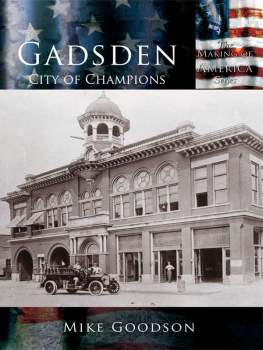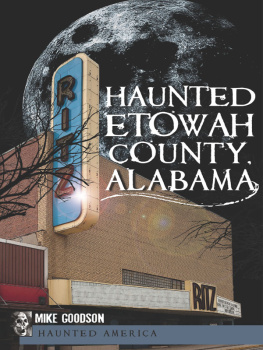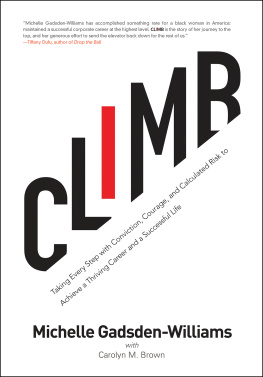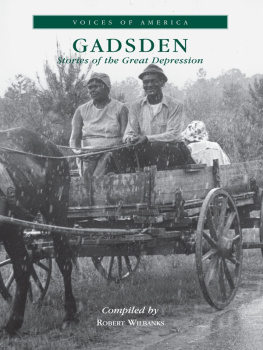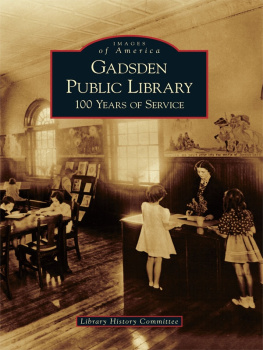ACKNOWLEDGMENTS
I am indebted to several people who have done much over the past years to record the city of Gadsdens rich and colorful history. Several individuals have preserved different events in this citys history in a variety of waysfrom photographs to written wordsthat have helped to make this publication possible. Several important organizations have also been diligently at work for many years preserving and recording our local history, including the Etowah Historical Society and the Alabama City Historical Association. Specifically, I would like to acknowledge Linda Parker, who has restored the John Riley cabin, which was originally located at Double Springs.
Some important individuals have recorded Gadsdens history in written words including Charlie Boman, Will Martin, Bob Ginger Johnson, and Joe Barnes. Adolph Lebourg had a unique gift with a camera and recorded everyday life in downtown Gadsden. This gift has given many people a glimpse of life in the City of Champions during the 1920s through the 1950s.
Probably the single-most important attempt to record the history of Gadsden is in the form of a collection of photographs that have been amassed by local historian Bob Scarboro. Over the years, Scarboro has built an unbelievable collection of over 6,000 vintage photographs of Gadsden and surrounding Etowah County that date back into the mid- to late 1800s. Photographs from this collection have been used to illustrate many books on the North Alabama area, including two books in the Images of America series. The books on Etowah County were co-authored by Scarboro and myself. Most of the illustrations contained in the pages of this work came from this priceless collection, and I owe a great debt of gratitude to the owner of it.
A special note of thanks is also extended to Barbara Reed and the staff of the Gadsden Public Library, without whose help this book would not have been possible. The immense resources of the Gadsden Public Library, including Gadsden newspapers dating back to 1867, have made researching this citys history an exciting journey.
There are many other people who have helped to make this possible. For anyone who has taken time to share a story on the early days of Gadsden or a cherished photograph that has been handed down for many generations, I am grateful.
And finally, a special note of thanks to Ann, who has spent untold hours typing, proofreading, and correcting these pages.
SELECTED BIBLIOGRAPHY
BOOKS AND PUBLICATIONS
Barnes, Joe. Gadsden, Alabama: A Short History . Gadsden, AL: Santos Printing, 1992.
Crownover, Danny. Black Creek Southern Lookout Mountain . Gadsden, AL: M & F Printing, 1983.
Etowah County Centennial Committee. The History of Etowah County . Birmingham, AL: Roberts & Son, 1968.
Dwight Manufacturing Company. Alabama City: Its Location and the Advantages It Offers the Working Man . Alabama City, AL: Dwight Manufacturing Company, 1900.
Martin, Will I. If Memory Serves . Cleveland, TN: Banner Print, 1952.
Nevile, Bert. Steamboats on the Coosa River in the Rome, Georgia, Gadsden, Greensboro, Alabama Trades: 18451920 . Selma, AL: Selma Printing Service, 1966.
Womans Club of Gadsden. Gadsden: A Little Book about Gadsden, Alabama . Gadsden, AL: Department of Archives and History of the Womans Club of Gadsden, 1938.
NEWSPAPERS
The Gadsden Daily News
The Gadsden Evening Journal
The Gadsden Times
The Messenger
Find more books like this at
www.imagesofamerica.com
Search for your hometown history, your old stomping grounds, and even your favorite sports team.
1. INDIAN LORE AND LEGEND
For many years the only inhabitants to live in the area today known as Gadsden were members of the Creek and Cherokee Indian Nations. During the late 1700s and early 1800s, this area was part of the Mississippi Territory. Part of the land of Etowah County was considered neutral ground among the different Indian tribes that lived in this area. These Indian villages grew along the beautiful Coosa River, which brought life to the area and would eventually bring the first white settlers.
Of the many Indian villages located along the banks of the Coosa River, probably the most famous was the land of Chief Little Turkey, or Turkeys Town. This Cherokee stronghold later became known as Turkeytown and stretched from near Centre in Cherokee County to just south of the present site of Gadsden in Etowah County, where the Coosa River and Wills Creek meet.
General Andrew Jackson passed through this area in a southerly direction during the War of 1812, cutting what is known as the Strother Road to Fort Strother at Ten Islands on the Coosa River and, from that point, marching to the battles of Tallassahatchee, Horse Shoe Bend, and Talladega. On his return from these battlefields, he marched to Turkeytown, crossing Wills Creek at what is known as Jacksons Ford, 2.5 miles from Gadsden, and passing through where Gadsden now stands. At Turkeytown, he concluded a treaty with the Cherokee Indians. In December 1832, the Creek and Cherokee Indians met on a large field near the banks of the Coosa River to settle a dispute over their lands near Gadsden. Rather than fighting to settle this problem, the Indians played a form of stick ball similar to modern-day lacrosse. The stake to the winners was a strip of neutral territory 4 miles wide on the boundary line between the Creek and Cherokee Nations, and this land was to be taken from the losing side. The contest was decided in favor of the Creeks. Future disputes between these two nations were settled on this field known as Ball Play near the present-day city of Gadsden. Some of the white settlers in the area were on hand to watch some of these contests.
In 1836, part of the Creeks, under the leadership of Neomicka, Neomathla, and Jim Henry commenced hostilities against white settlers in the area but surrendered in June of the same year. The leading men of the hostile party were taken prisoner and sent west in chains. Opathleola and Jim Boy, friendly Creek chiefs with 1,400 Creek warriors, were fighting alongside the whites during this campaign. All the hostile party was removed in 1836, and the friendly portion of the Creeks was removed in 1837. The Cherokees were removed in 1838. They were all collected at Ross Landing, now Chattanooga, by the government of the United States, then carried west to the Indian Territory. The Cherokee Chief Stan Wattie, who later served as a Confederate States general in the Trans-Mississippi Department during the Civil War, was born at Turkeytown in this county.
Today, many artifacts are found along the banks of the Coosa River from Centre to Whorton Bend near Gadsden. Arrowheads, pieces of pottery, and small beads can still be uncovered while walking along the riverbanks or searching through freshly plowed fields in and around the area known as Ball Play. These small artifacts are a reminder of two proud Indian nations that were the earliest residents of the future city of Gadsden.
Probably the best-known story about the days of the Indians living in the Gadsden area dates back to just after the Revolutionary War. It was during this time that the legend of Noccalula was born. This legend was first printed in the pages of the Gadsden Times in 1869 and has grown over the years. The story has been enjoyed as a legend for more than 100 yearsbut is this simply a legend or a story of fact?

